Simrad Go12 XSE and Halo20, capable and cost-effective small boat navigation
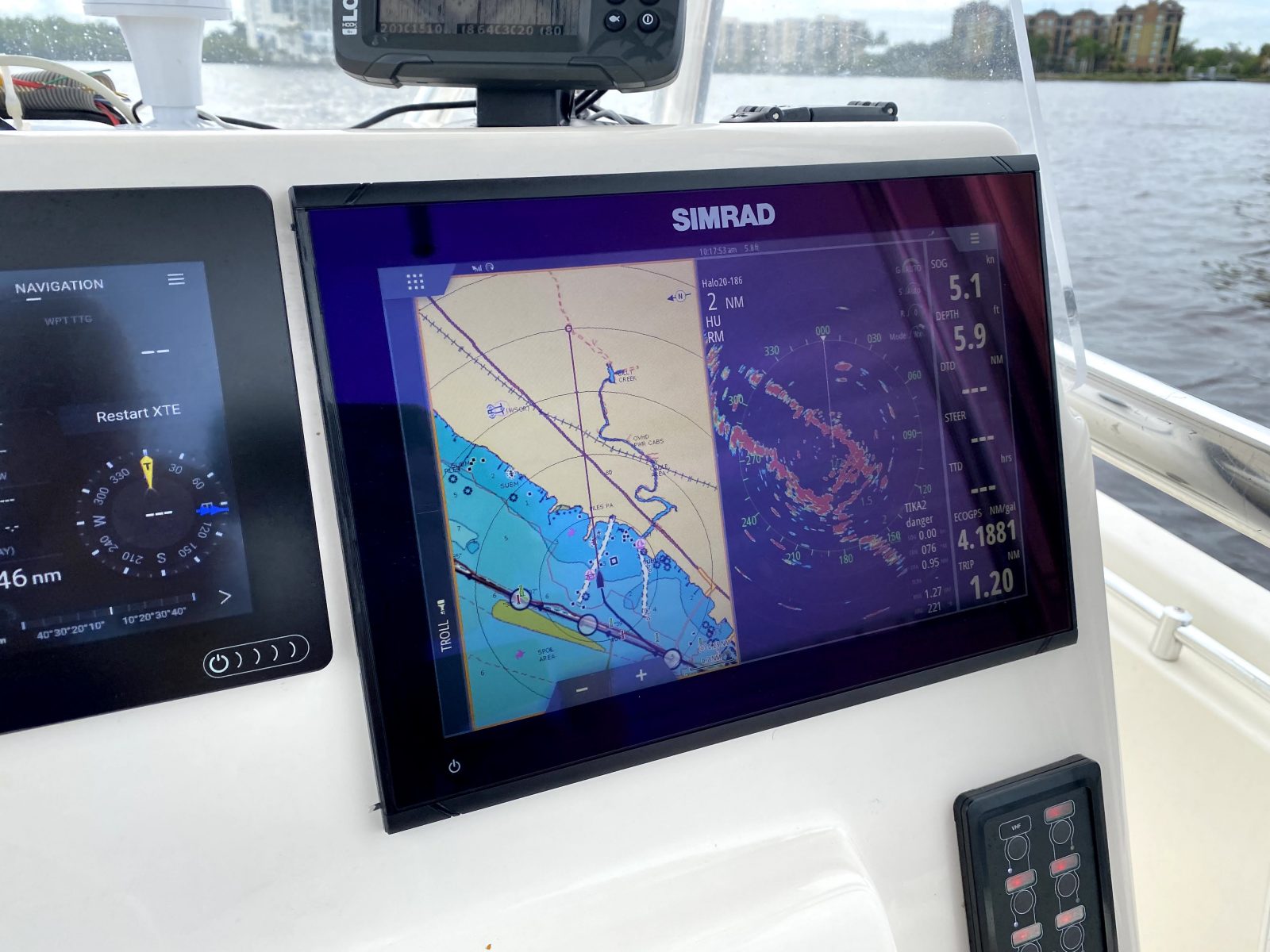
Simrad’s Go12 XSE may be from the value-oriented Go line, but I’m impressed at its performance and capabilities after installing it aboard Panbo(at). Plus, paired with Simrad’s Halo20 radar this 22-foot center-console has great nighttime and foul-weather visibility. All of this from an electronics package with a list price of less than $4,000.
Garmin, Raymarine, and Simrad all offer value-oriented MFDs that can be paired with affordable radar scanners. I think there’s a common misconception that these options aren’t adequate for more challenging navigation. But, all three options run the same or similar software as their more advanced and expensive siblings. In most cases, the price difference comes down to screen resolution, advanced features, and frequently touchscreen- or button-only controls instead of both. But, in my experience, the one thing that isn’t compromised is core navigation and safety capabilities and I think you will find that the value options from today will outperform the high-end MFDs of only a few years ago.
The Simrad Go lineup consists of 5, 7, 9, and 12-inch models. The 5-inch model lists for $420 while the top-of-the-Go line 12-inch option carries a list price of $2,150. The 5-inch option is the only one without an Ethernet port which means you can’t connect radar to it. All Go MFDs are designed for single display installations so you won’t be able to share chart, radar, and sonar data with other Ethernet displays like you can with their big brother NSS and NSO MFDs.
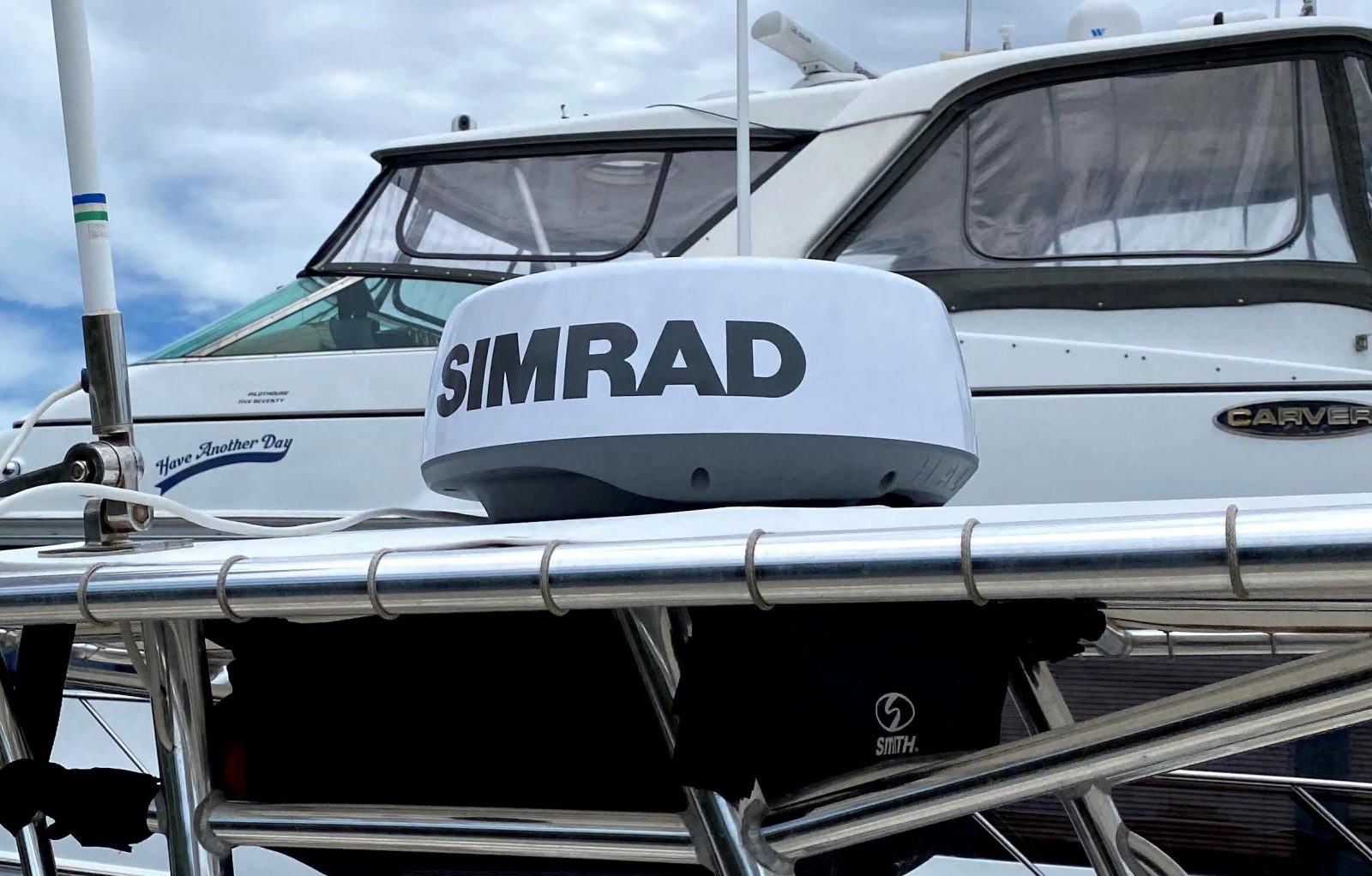
Simrad (and their corporate parent Navico) introduced solid-state radar to the recreational market 12 years ago — how time flies! — so they’ve had quite a long time to refine the technology. The Halo20 I installed on Panbo(at) shows this refinement. For a $1,700 list price, you can pair a 24 nautical mile, 24 RPM, 13-pound, 10-watt radar dome to your Go MFD. The Halo20 does not offer doppler target motion identification, but for $2,200 list Simrad offers the Halo20+ with 36 nautical mile range, doppler motion detection, 60 RPM scanning speed, dual-range, and bird mode.
Go12 XSE and Halo20 on the water
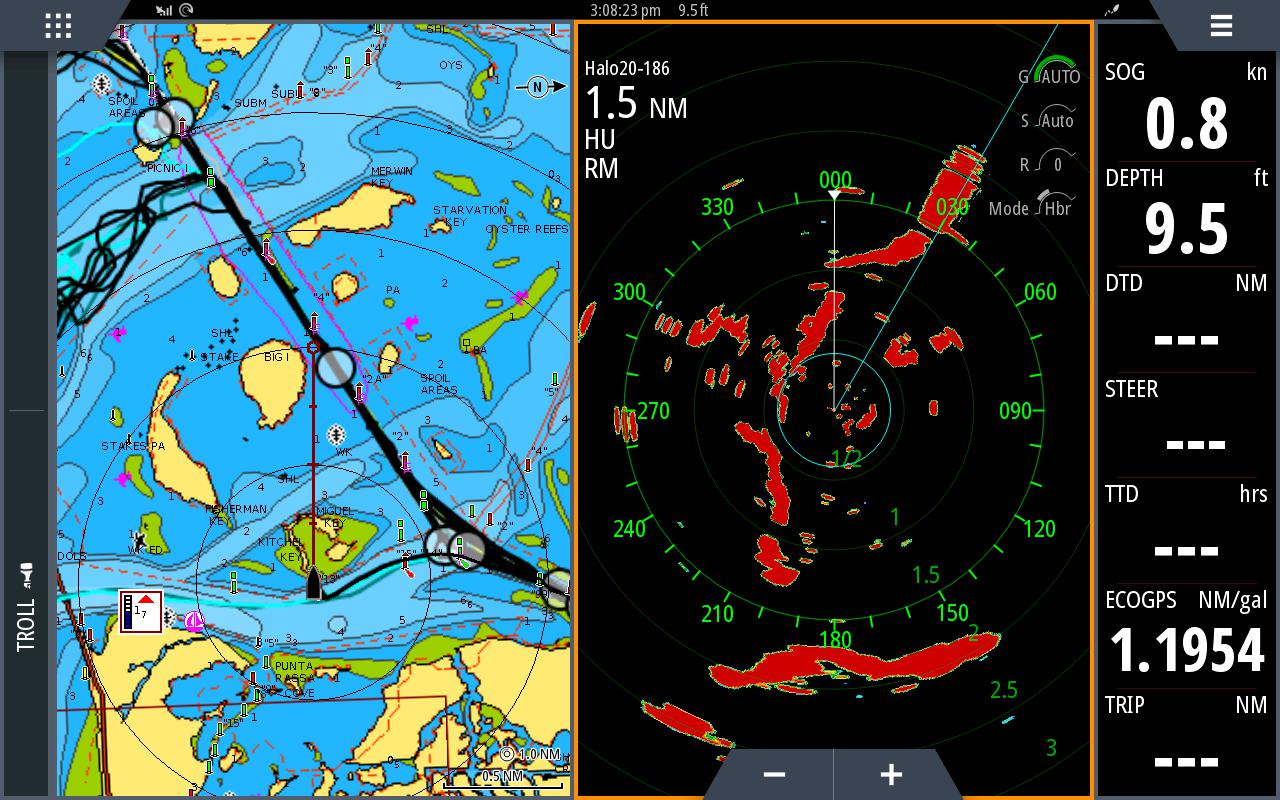
It bears repeating that these entry-level products deliver all of the safety tools you’re likely to need on the water. Especially on the types of boats for which these systems are designed. Installed on my 22-foot center console I’ve never found 24nm of radar range to be in any way inadequate, the display not bright enough, or the system too slow. In fact, I often found myself forgetting this was a value-oriented product. Its performance, for how I use it on a smaller, open boat, has been great. The 12-inch display is a good size to allow clear presentation of a chart or radar scope in full-screen mode or splitting the screen in half and displaying both charts and radar together.
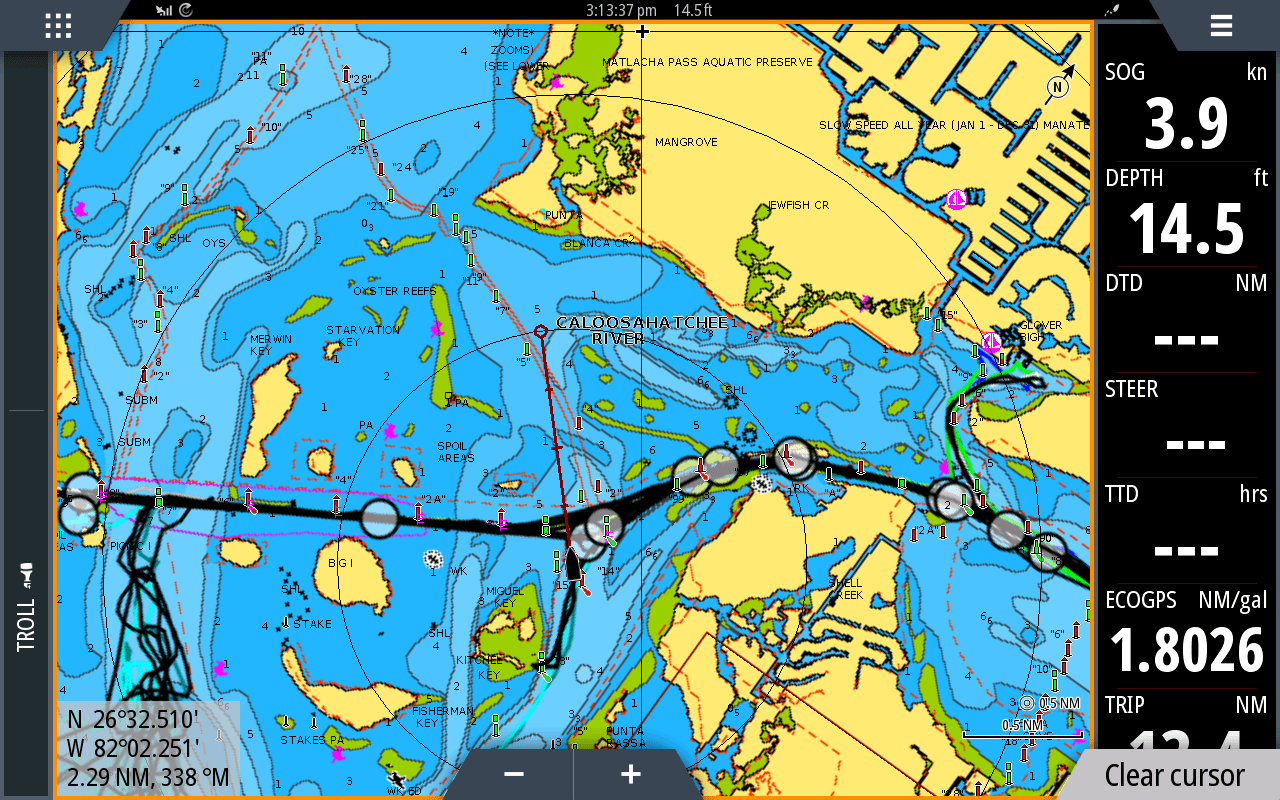
Like all Simrad MFDs, Go plotters can use C-Map or Navionics cartography and display both nicely. The performance of the Go 12 rarely reminded me it wasn’t the top of the line MFD. Though I did occasionally find that scrolling isn’t as fast or as seamless as the more expensive MFDs. So, what are you giving up by not with the most expensive option? There are a few things and none of them are deal-breakers, but together they might add up to a push towards an NSS Evo3.
Upgrading to an NSS Evo3 MFD will get you an IPS display with wider viewing angles and better visibility with polarized sunglasses on (though the Go12 can also be viewed with polarized lenses). Additionally, the EVO3 upgrades from the Go’s single-channel, 600-watt sonar to a dual-channel 1,000-watt sounder. The Evo3 series also includes greater connectivity with composite video inputs, HDMI output, dual Ethernet ports, and two SD card slots for charts and additional storage. Plus, while both an EVO3 and Go XSE can control a Simrad autopilot the Go12 still requires a separate AP control head or keypad because it lacks the physical standby button required by safety regulations.
I’ve always really liked the way Simrad displays their list of AIS targets, but never cared for the oversized triangle used for showing AIS targets on screen. Frustratingly, that triangle always seems oversized and doesn’t scale very gracefully as you change zoom levels on a chart.
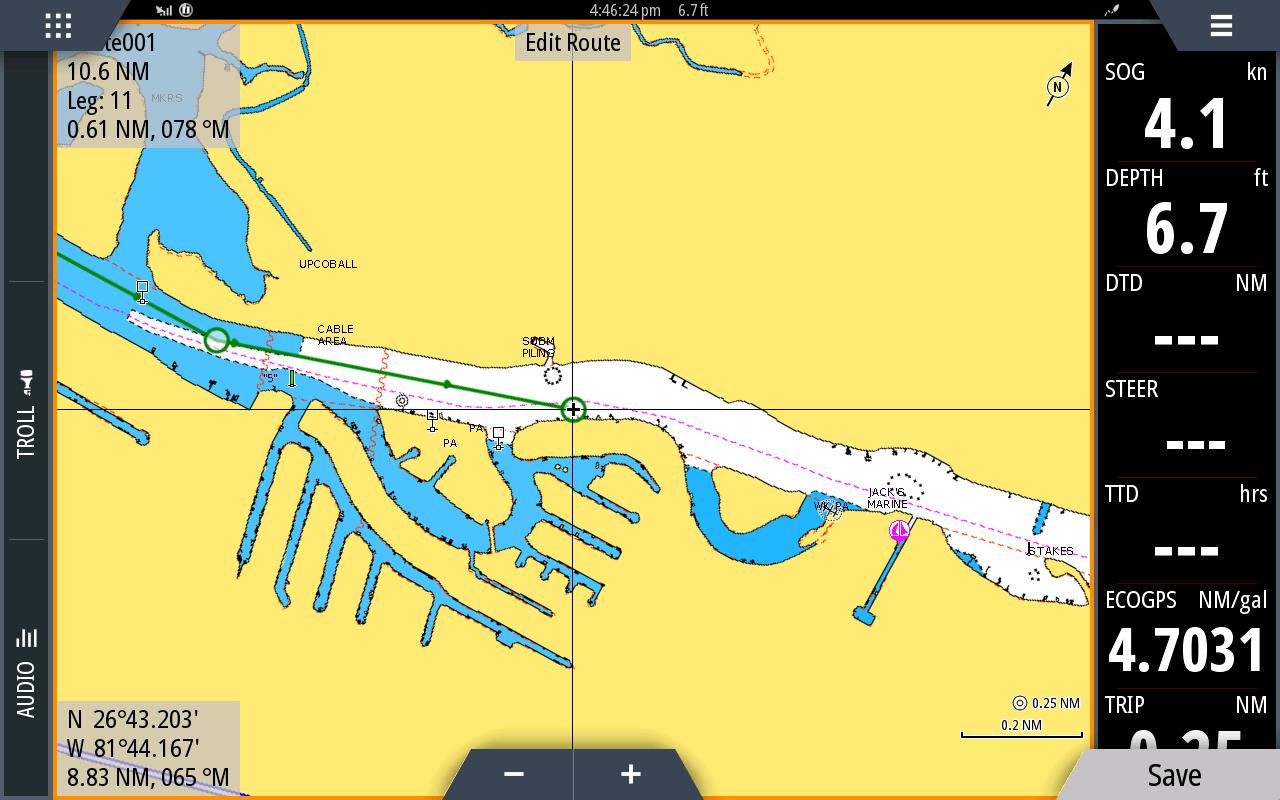
I find Simrad’s approach to route building easy to use and intuitive. Plus, I really appreciate that the MFD displays the length of the last leg added and the total route length. Both C-Map’s Easy Routing and Navionics’ Autorouting are available with the appropriate cartography card to make routing even easier — but, please, verify those automatically generated routes carefully.
The Go12XSE offers quite a few gauge pages for displaying navigation, engine, and other data that’s available to the MFD via NMEA 2000. I like the layout of Simrad’s gauge pages and appreciate that they’re more configurable than some other MFDs — I’m specifically thinking of Raymarine’s otherwise excellent engine gauges, the most graphically impressive of which can only be turned on and off, not customized at all.
I’d still like more flexibility in not just being able to change what data is displayed by an on-screen gauge, but also the placement of the gauge onscreen. In an ideal world, (and this doesn’t seem like that big of an ask but I haven’t seen any MFD do it) I’d like to be able to pick from a palette of gauges, place them on the screen where I want and configure the data displayed. I’d written that paragraph before Ben E. pointed out to me that I’d missed the release notes for the Simrad version 20 upgrade. It turns out Simrad delivered exactly what I have wanted. You can start with a blank dash or one of the existing ones and then edit to your heart’s content. You can add gauges, text, graphs and more. The gauges you see above took just a few minutes to put together and while they could still use a little more tweaking I’m thrilled.
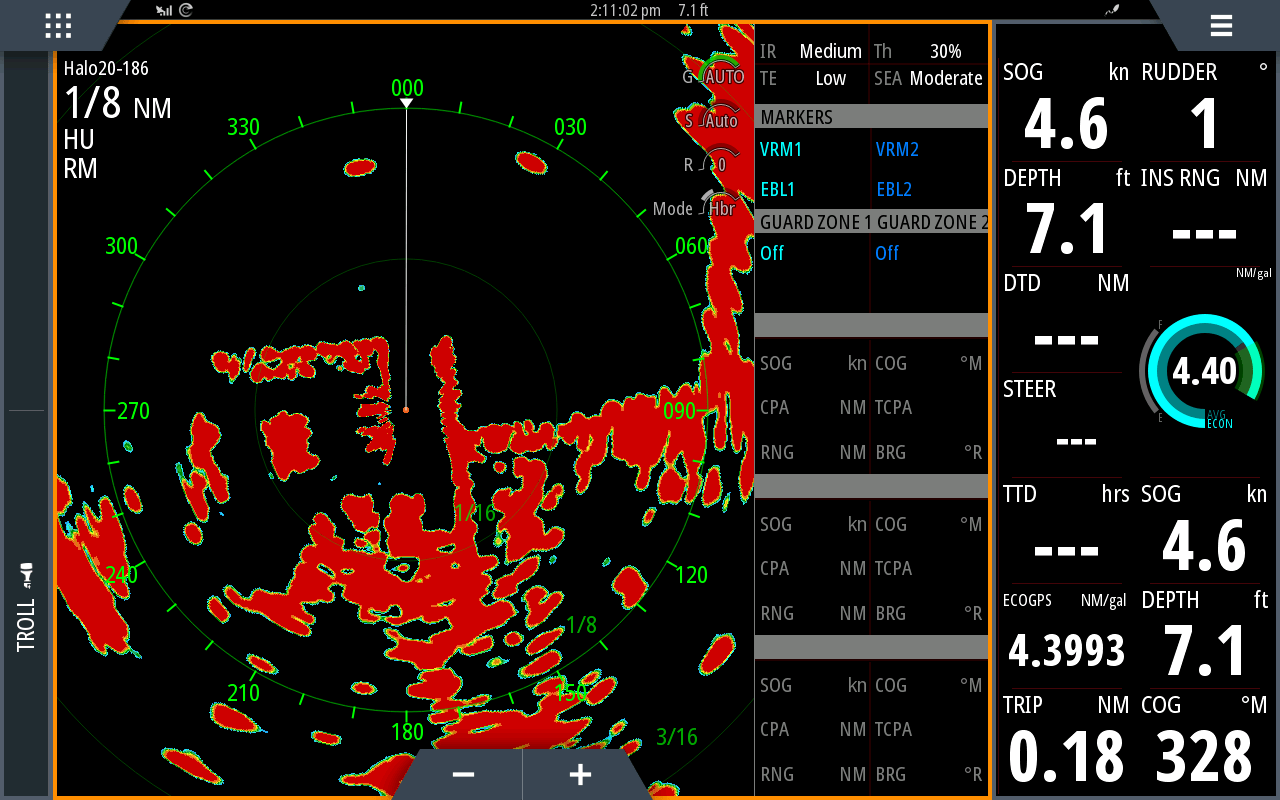
Radar performance has been, in my opinion, excellent. I don’t have another radar unit on the boat to perform direct comparisons but I’m consistently impressed at the job done by this affordable, relatively low-powered unit. Panbo(at) spends a lot of its life running up and down the Caloosahatchee River, which means there are targets returning all around the boat. I’ve come to expect lesser performance in these circumstances — especially with magnetron radars — because of the amount of energy absorbed by all these targets. When I read the power specs of the Halo20 I wondered if a 20+ would have been a better fit for my boating. While it’s certainly possible the Halo20+ would perform even better, the work the 20 does is already impressive.

Spending the summer months in southwest Florida with the frequent afternoon storms has given me a good opportunity to test the weather capabilities of the radar. I’ve been pleased with these results as well. The ability to watch storms move in and duck around them has helped me avoid getting soaked a few times (though my track record is far from perfect).
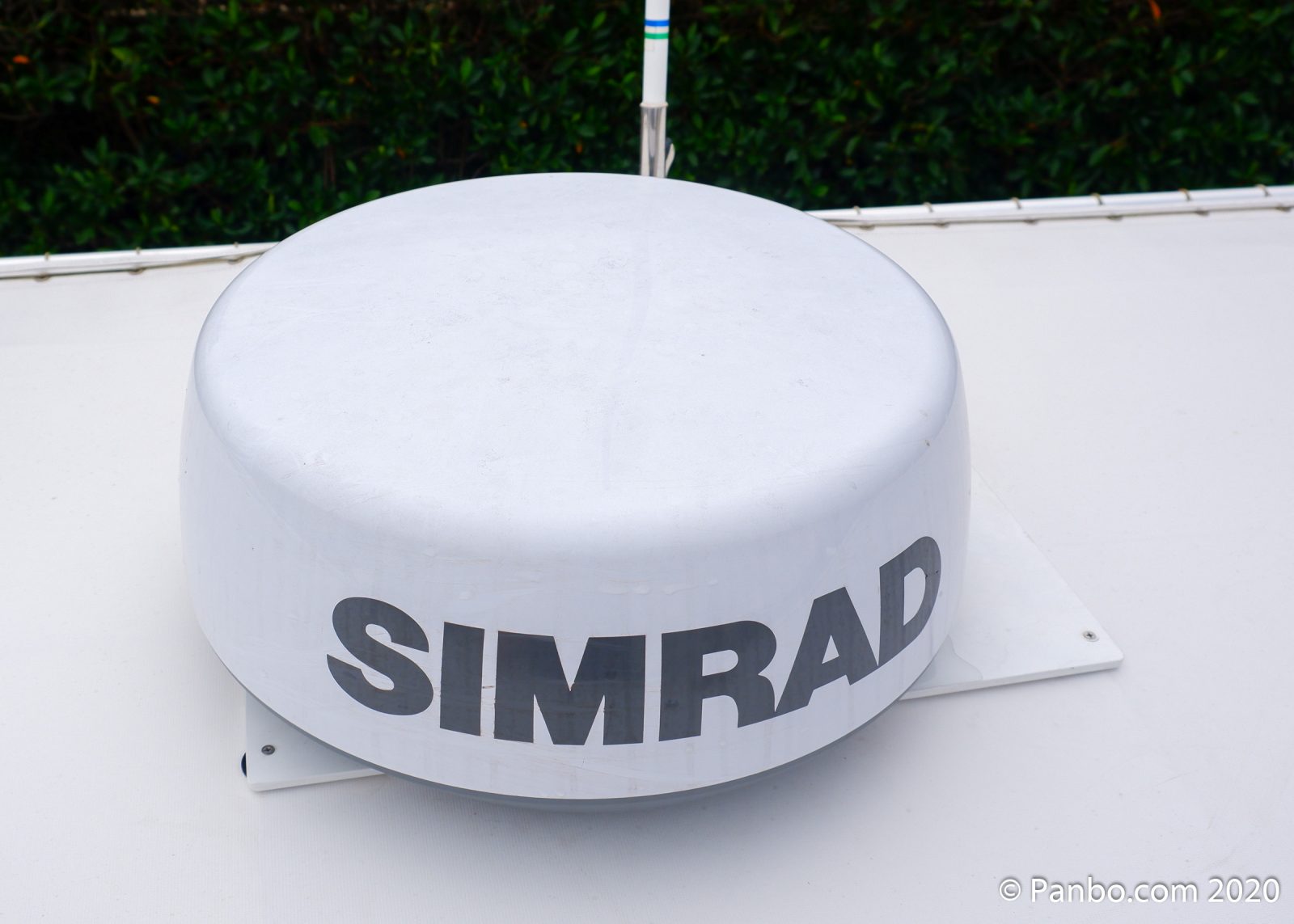
The low profile and 13-pound weight of the Halo20 make it a good fit for a small boat with a soft-top like Panbo(at). I ended up having a mounting plate made by a small company called Nautical Creations. Some of the bridges over canals in my area are pretty low so, in an effort to keep bridge clearance as low as possible, I didn’t want to use a traditional pedestal mount. I was very pleased with their ability to customize a plate to my needs and thought the price was exceptionally reasonable. I can heartily recommend them.

Go MFDs can control audio devices connected via NMEA 2000. Above you can see the audio bar controlling the Fusion Apollo RA-670 installed on Panbo(at). The audio controls are available on the left side of the screen, regardless of what application is currently onscreen.
I like Simrad’s handling of trips a lot. As soon as the boat starts moving a prompt comes up asking if you’d like to start recording a new trip or add to the current trip. I like the display of recorded trips with a quick route overview displayed. However, you can also see one of the quirks I’ve observed with the Go12. Despite the integration with my NMEA 2000 linked Yamaha F150 outboard — and the successful capturing of trip fuel economy — the MFD doesn’t capture fuel burned for the trip and I haven’t been able to figure out why.
As you can probably tell, I’ve been pleased (and a little surprised) at the capability and full feature set this system provides. There are some nice-to-have features that are left behind, but not a single one that I’ve thought was critical. I think the biggest driver to an NSS system, especially on larger boats than mine, is the limited networking capabilities of the Go line. But, when it comes to making your time on the water easier and safer Simrad’s Go12 and Halo20 does it well without breaking the bank.
















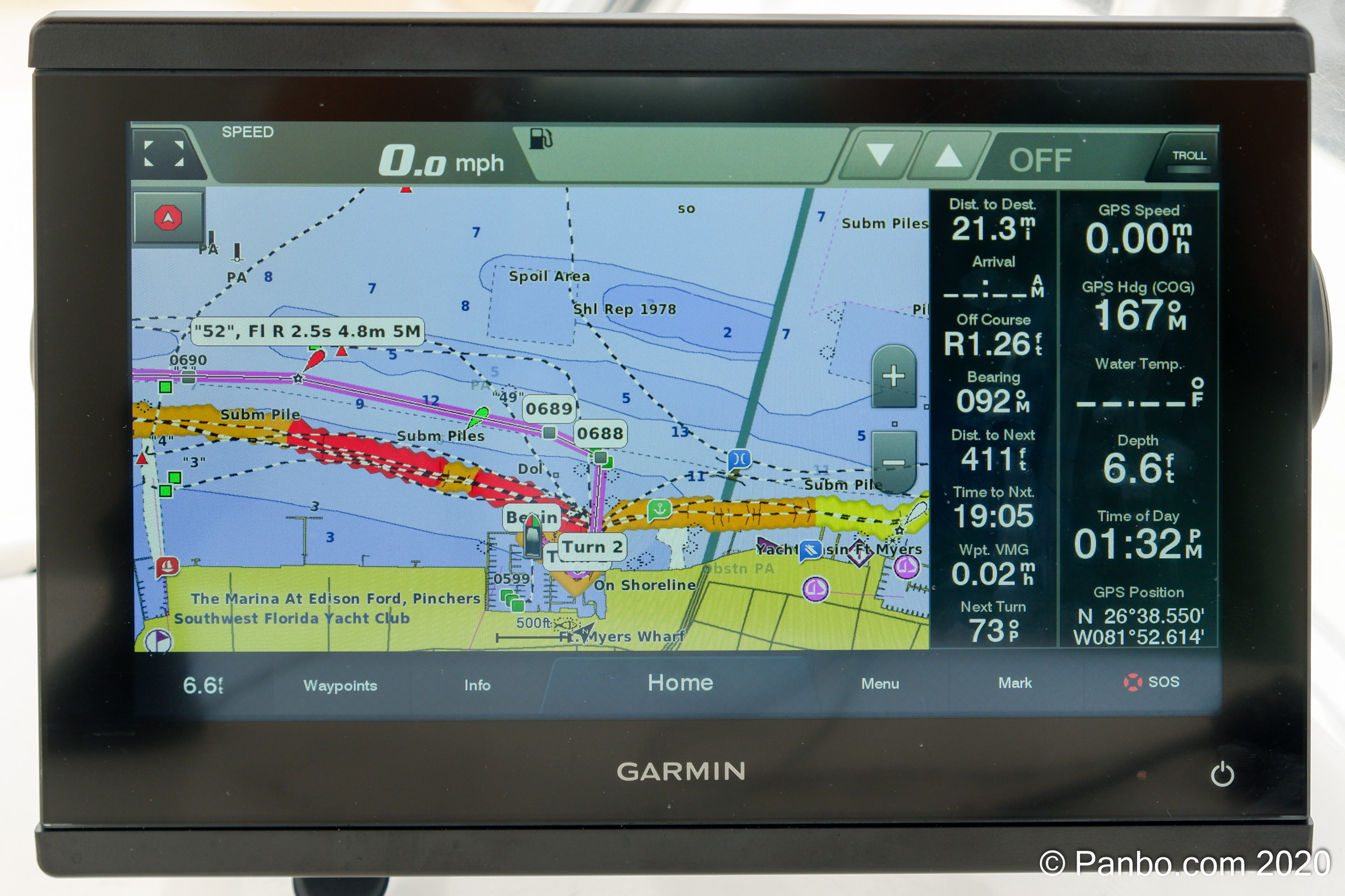







Might I recommend Florida Marine Tracks from ISLA Mapping for your NAVICO Simrad unit although the Go series requires cards to be inserted in the rear of the unit and not in an easily accessed pair of slots on the front as the NSS EVO3 series. The new NSS EVO3-s units have twice the processing power so screen refresh is significantly improved.
The FMT mapping and photography should be compared to the industry standards to realize how much of an improvement they are. YouTube has examples which very likely cover an area that any Florida boater is familiar with.
Quick small boat radar question. A few years ago I think there were several smaller radomes, like 12-15″. It now looks like just Furuno has a 15″ left (and not a very modern one). Is there a reason for that? Issues with the smaller antenna? When you get to thinks like under 30′ sailboats mounting the bigger antenna unobtrusively can be an issue.
Colin, maybe you realize this but a radar’s horizontal resolution is limited by the width of its antenna, so small radomes have trouble differentiating close together targets like a boat next to a navaid buoy.
https://www.furuno.com/en/technology/radar/basic/
So the beam width on the 15-inch Furuno 1623 that came with my Maritime 20 is a low res 6.2 degrees, though I found what it can do useful enough that I kept the dome and can install the head unit if needed. Also, the Si-Tex T-760 looks like a decent 18-inch radome system:
https://www.si-tex.com/item/t760seriestouchscreencolorradar
But many of the solid-state 20-24 inch radomes can improve on resolution with advanced digital signal processing, and are also light and power-efficient… probably why I see them commonly on smaller sailboats here on the foggy coast of Maine.
Thanks Ben, it’s been a while since I have dug into radar (last installed one around 2007). It came up as I have been looking at getting a small cruising boat again (under 34′) and on some designs larger Radomes look ungainly. I had kind of figured there was an issue like you mentioned, The Sitex is high on my list. Never had a radar on my personal boat before.
Hi Ben,
You need to incorporate a Lowrance fuel data manager into your n2k network to be able to get fuel burnt on the screen.
https://www.lowrance.com/en-au/lowrance/type/sensors-networking/fuel-data-manager-pk/#prl_key_features
My two cents on the Halo20 versus the Halo20+: I think that the extended range, independent dual range plotting windows, high-speed close-range tracking, and Doppler technology in the + model are worth the $500 cost difference. Moreover, it looks like the current $4,199 package of GO12, Halo20+, Active Imaging transducer, and C-Map Pro card reduce that price difference significantly.
I suspect you’re right but this also might be an instance of not knowing what I’m missing. Doppler tracking would be especially nice on the river where there are frequently lots of moving targets to go with a lot of stationary returns. Color coding those targets would certainly help improve situational awareness.
-Ben S.
Right, I think that what Simrad calls VelocityTrack would be darn useful in that situation. Moreover, I think that Simrad, Garmin, and Raymarine are all trying hard to get their Doppler radars to do the automatic tracking that Furuno NXT can do so well. Then you’d not only see the dangerous moving targets but their precise heading and speed, with no effort on your part. No guarantee, but I suspect that may be a coming feature of the Halo20+ but not the Halo20.
How about a comparison between Halo 20+ and Halo 24?
Ben,
In a prepurchase contemplation I’ve been trying to figure out if I can get the Halo 20 to show up on my iPad independent of what’s showing on my Go9. Essentially, the Go9 for plotting and auto pilot and the iPad Air for the radar data on Navionics and such.
Any experience running the radar data into a ethernet router and then using it independently of the MFD?
Thanks!
Jason, unfortunately, what you’re hoping to accomplish won’t work. Although radar communications occur over Ethernet, the decoding and processing of that data is proprietary to each manufacturer and they don’t make it available on mobile devices (with the exception of one Furuno WiFi radar unit).
You can mirror the screen of your MFD on your iPad, but not run another function.
-Ben S.
Thank you!
I really appreciate the clarification
Ben Stein is correct but some radar codings have been reverse engineered, including Halos, and can be seen and operated with this OpenCPN plugin:
https://opencpn.org/OpenCPN/plugins/radarPI.html
Apparently there’s also a way to serve OpenCPN to an iPad, but a Windows tablet running the software might be a lot more robust. Or maybe get the least expensive GO that will work with the Halo 20 and use the Link app to see it better on the iPad. I use a GO5 that way for backup chartplotting and StructureScan and it’s OK though a little laggy.
Great overview, thank you or taking the time
1